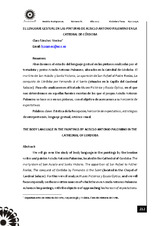El lenguaje gestual en las pinturas de Acisclo Antonio Palomino en la Catedral de Córdoba
The body language in the paintings by Acisclo Antonio Palomino in the Cathedral of Cordoba
Autor
Sánchez Merino, Clara
Editor
UCOPressFecha
2017Materia
Estética de la RecepciónHorizonte de expectativas
Estrategias de interpretación
Lenguaje gestual
Retórica visual
Aesthetic of Reception
Horizons of expectation
Strategies of interpretation
Body-language
Visual rhetoric
METS:
Mostrar el registro METSPREMIS:
Mostrar el registro PREMISMetadatos
Mostrar el registro completo del ítemResumen
Abordaremos el estudio del lenguaje gestual en las pinturas realizadas por el tratadista y pintor Acisclo Antonio Palomino, ubicadas en la Catedral de Córdoba: El martirio de San Acisclo y Santa Victoria, La aparición de San Rafael al Padre Roelas, La conquista de Córdoba por Fernando III el Santo (situadas en la Capilla del Cardenal Salazar). Para ello analizaremos el tratado Museo Pictórico y Escala Óptica, en el que nos detendremos en aquellas fuentes escritas de las que el propio Acisclo Antonio Palomino se hace eco en sus pinturas, con el objetivo de acercarnos a su horizonte de expectativas. We will go over the study of body language in the paintings by the treatise writer and painter Acisclo Antonio Palomino, located in the Cathedral of Cordoba: The martyrdom of San Acisclo and Santa Victoria, The apparition of San Rafael to Father Roelas, The conquest of Cordoba by Fernando III the Saint (located in the Chapel of Cardinal Salazar). For this we will analyze Museo Pictórico y Escala Óptica, and we will focus especially on those written sources of which the own Acisclo Antonio Palomino echoes in his paintings, with the objective of approaching his horizon of expectations. We will go over the study of body language in the paintings by the treatise writer and painter Acisclo Antonio Palomino, located in the Cathedral of Cordoba: The martyrdom of San Acisclo and Santa Victoria, The apparition of San Rafael to Father Roelas, The conquest of Cordoba by Fernando III the Saint (located in the Chapel of Cardinal Salazar). For this we will analyze Museo Pictórico y Escala Óptica, and we will focus especially on those written sources of which the own Acisclo Antonio Palomino echoes in his paintings, with the objective of approaching his horizon of expectations.

